Steering Wheel Turns By Itself While Driving (9 Common Reasons)
If your steering wheel turns on its own, it could be from a few things. The main reasons include unevenly worn tires, broken steering parts like steering rack, tie rods, or strut mounts, and brake problems like a stuck caliper or air trapped in power steering fluid lines. To fix, make sure tires are inflated properly, bleed out air from the power steering system and repair stuck brakes.
Have you ever gotten into your car, started driving, and noticed the steering wheel slightly turning on its own? This can make you worried. It can feel like you lost control.
But a small amount of wheel turning or pulling is normal sometimes. We will talk about what causes it. Things like:
- Alignment problems
- Parts being loose
- Other issues
We will also share when you should take your car to a mechanic. If the problem seems bad, have them look at it.
- Uneven tire wear causes steering wheel to turn on its own by changing alignment and camber when hitting bumps.
- Misaligned steering column from aftermarket parts disturbs angle, making wheel drift.
- Worn steering rack bushings transmit vibrations to wheel, causing jerking movements.
- Sticking brake calipers create imbalance in wheel resistance, pulling the vehicle and wheel.
- Damaged brake hoses reduce fluid pressure unevenly, dragging car and wheel to one side.
- Broken steering shaft in electric power steering disconnects wheel from tires, causing it to spin freely.
- Bad strut mounts create play in the wheel and reduce steering control.
- Trapped air pockets in power steering lines take away proper fluid pressure control.
Causes Of Steering Wheel Turning By Itself
Here are the causes of a steering drifting side to side:
- Too wide tires
- Bulge in tires
- Uneven tire wear
- Low tire pressure
- Steering Column is not misaligned
- Dragging or stuck brake calipers
- Collapsed brake hose
- Damaged bushing of the steering system
- Malfunctioning Torque sensor of the steering system
- Broken drive shaft of the electric power steering system
- Damaged clockspring of the electric power steering system
- Damaged clocksprings/slip ring in steering system
- Bad Strut tower mounts and control arm
- Trapped air in power steering system
1. Too Wide Tires or Uneven Tire Wear
Too wide or large tires cause the steering wheel to turn by itself if you suddenly stop the vehicle or when you driving a vehicle. Also, the uneven wearing of the tire or any bulge in a tire tread changes its alignment and camber. So, any bump or pothole in the road will cause the steering wheel to turn by itself.
Why does it happen?
When a vehicle is stopped, the weight shifts forward and the tires are forced into the ground even harder. The tire tread and rims may be damaged if the vehicle goes over bumps or potholes.
The sinking of tires deeper into the ground is more common when a vehicle is traveling at low speeds and has a lower forward momentum.
So, due to the hard pushing of tires against the ground, they are forced to follow the angle a pothole or a bump makes with the ground.
Installing wide tires also increases the lever arm length i.e. the distance between the steering knuckle joint and the outside edge of the tire.
As a result, any force applied to the wide tire by grooves or bumps on the road is effectively generating more torque, thus forcing the wheel to follow the road cambers and turn the steering wheel automatically.
How to spot?
Try to swap the tires from front to back. If the issue is fixed, it means the problem is in the tires.
How to fix?
If the steering wheel is turning by itself due to wide tires, you can fix this problem by increasing the caster angle of the steering wheel axis and the positive camber of the tire.
To understand the caster angle, you can watch below Youtube video:
To learn SAI and camber, you can watch the following Youtube video:
Actually, engineers have set the steering angle inclination (SAI), caster angle, and camber angle based on the stock tires.
If you are using aftermarket wide tires or your tires are unevenly worn or they have a bulge in their treads, they will force the steering wheel to move a little.
Thus, you would have to adjust the caster and camber angle accordingly if your vehicle has bigger tires than the stock tires.
2. Steering Wheel Is Not Aligned
The steering wheel can turn left or right by itself if the Steering Angle of Inclination and caster get disturbed. This can happen when you replace parts like:
- Aftermarket steering columns
- Tie rods
When you replace steering or suspension parts, it’s best to realign everything. This allows the right caster angle to be set. It also stops the steering column from moving back and forth.
3. Bad Steering Rack or Column Bushing
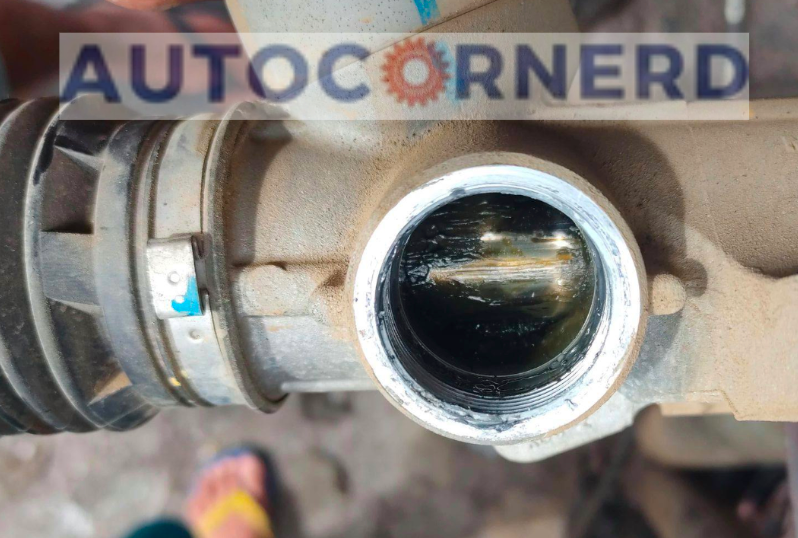
The steering wheel can wiggle left and right by itself if the bushings on the steering column or rack are bad. Worn out bushings, bad alignment, wrong tire size, or worn tie rod ends can also cause this.
The job of the steering column and rack bushings is to take in the vibrations from weight shifting around in the suspension when driving.
If the rack bushings are dry (need grease), worn out, or loose, they will transfer vibrations. This makes the steering wheel jerk around or suddenly turn left or right without you doing it.
To diagnose which part of the steering mechanism has a play in it, wiggle the steering wheel back and forth and listen to knocks or thuds. Also, lift the car front and wiggle the tires. The issue may also be in tie rod ball joints and rubber boots.
4. Dragging Brake Calipers
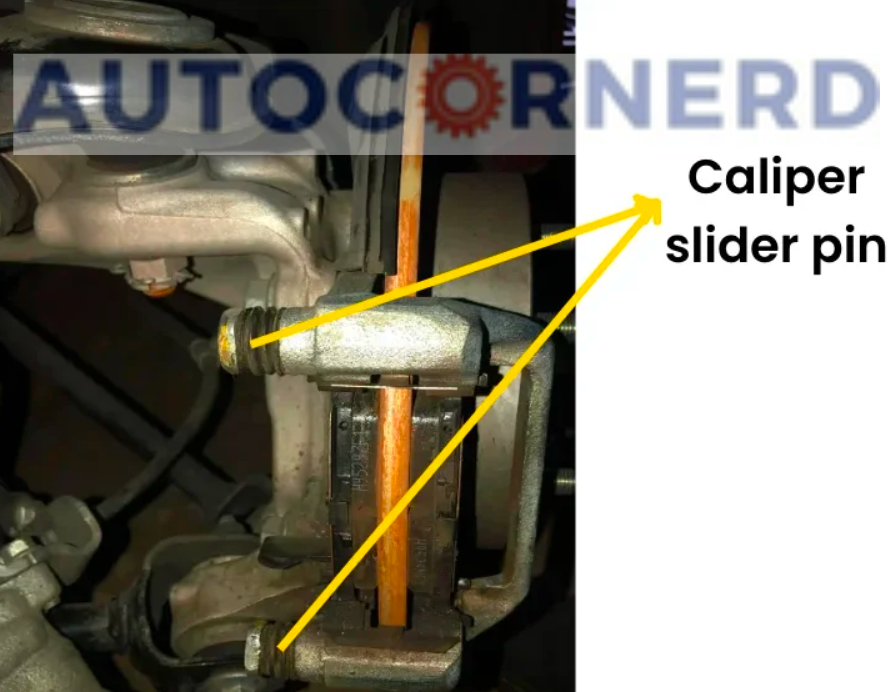
Your vehicle’s braking system uses friction to slow and stop the wheels from turning. The brake pads housed in the caliper clamp down on the rotor attached to the wheel when you press the brake pedal. This friction generates heat and force that slows the rotor down until it stops spinning.
If a brake caliper sticks and continues applying pressure to the rotor even when you are not braking, it will create extra resistance at that wheel. This has a direct effect on the steering system.
Here’s a closer look at how:
- The clamping force of a dragging caliper makes its wheel harder to turn compared to the others.
- This imbalance in wheel resistance causes that corner of the vehicle to slow down while the other wheels keep rolling at normal speed when coasting or accelerating.
- Having one corner of the vehicle dragging behind the others pulls the vehicle toward that side, causing the steering wheel to turn in that direction.
- The driver will feel a constant pull on the steering wheel toward the side with the sticking brake caliper.
Moreover, you should inspect brake pads/rotors for uneven wear patterns that indicate caliper drag over time.
How to fix?
Lubricate caliper pins and slides to restore normal operation if binding. I would recommend this one. You may also require new rubber seals and boots.
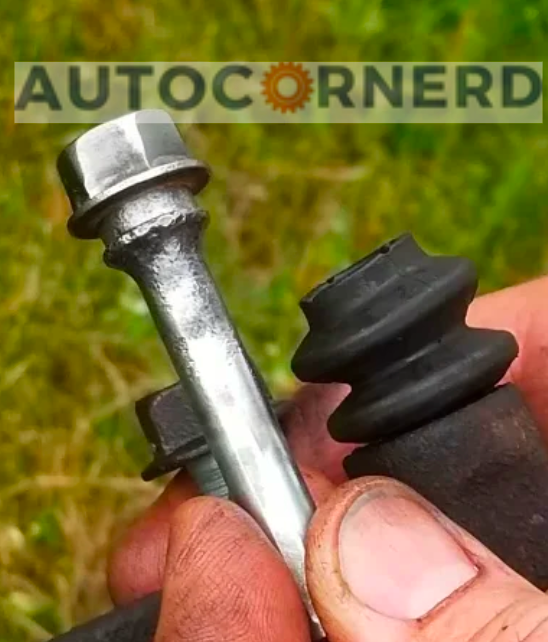
Note: Excessive lubrication can trap air at the tip of the slide pin, causing the caliper/pad assembly to drag on the rotor. As such, always ensure that you use the correct amount of lubricant when applying it to the slide pins.
5. Collapsed Brake Hose
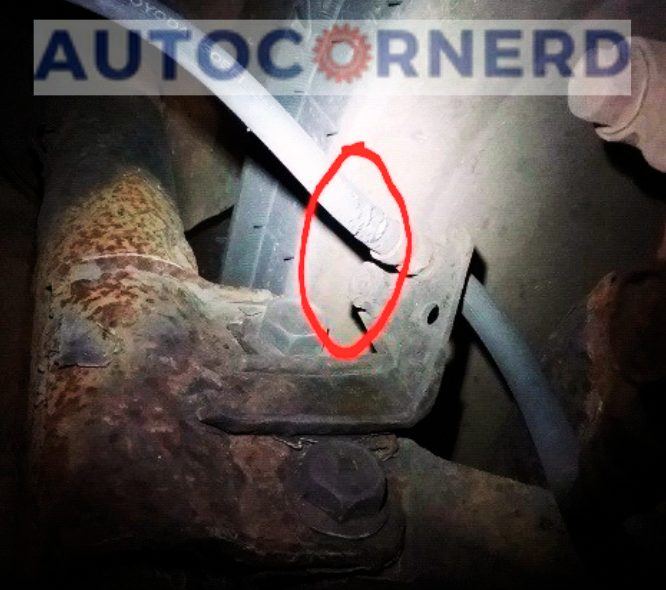
In a hydraulic braking system, the brake hose can collapse, causing the brake’s piston to slide unevenly, thus causing the vehicle and steering to pull to one side when braking.
You should visually inspect signs of swelling and cracks on the brake hose, especially in the areas near the fitting. At the fitting, the brake hoses are exposed to the greatest stress. The metal fitting can develop corrosion that can squeeze the brake hose, thus restricting the brake fluid flow.
When a brake hose is damaged, the brake fluid swells the hose as it flows through it. It reduced the hydraulic pressure.
As a result, the related brake caliper won’t be able to deliver as much braking force as the brake caliper on the opposite side of the vehicle.
So, the vehicle will pull towards the side where the brake hose is not damaged. So, if you see any signs of damage on the brake hose, you should replace it.
6. Malfunctioning Torque Sensors In Steering System
Modern engines, such as the 2007 Chevy Malibu and Hyundai vehicles have electrically controlled power steering systems instead of the hydraulic power steering wheel.
You can understand the working of the electric power steering system from the following Youtube video:
The ECU receives the input of torque applied by the driver to the steering wheel, steering angle, and vehicle speed to decide how much torque on the steering wheel has to be controlled by the motor.
If the torque sensor malfunctions, the ECU would not know the amount of force being applied by the driver. As a result, the motor may not be able to react quickly enough and the driver will feel the loss of control and feedback in the steering system, which will cause the steering wheel to turn by itself.
Most of the time, the sensors in the power steering system cannot be replaced individually, due to which you may have to replace the entire steering column assembly. This is not the case with all vehicles though.
Also, if the steering wheel shaft is broken in the electric power steering system, the steering wheel will continue to rotate in a single direction by itself as soon as you start a car.
When the steering wheel shaft is broken, it is no longer connected to the rack, thus making the steering wheel spin freely.
Since there is no connection of the steering wheel with the tires due to a broken shaft, the steering wheel will keep attempting to normalize itself to the wheel.
Also, you should check the clockspring connector or slip ring in the steering system. A car can have either a clockspring or a slip ring in its power steering system.
A clockspring is a rotary electrical connector that keeps contact with the steering wheel airbag and other electrical systems while the steering wheel is turning.
A clock spring consists of a loop that connects electronics in the steering wheel to the rest of the car.
If the clockspring is broken, the airbag light will also come on. So, depending on whether your car has a clockspring or slip ring, the chances are that it might need to be replaced.
7. Bad Strut Tower Mounts and Control Arm
A strut tower is a part of the suspension system that connects the vehicle’s frame to the body. Strut tower has a strut mount at the top that has a strut bearing. The strut bearing is located between the shock-absorber spring and the car body.
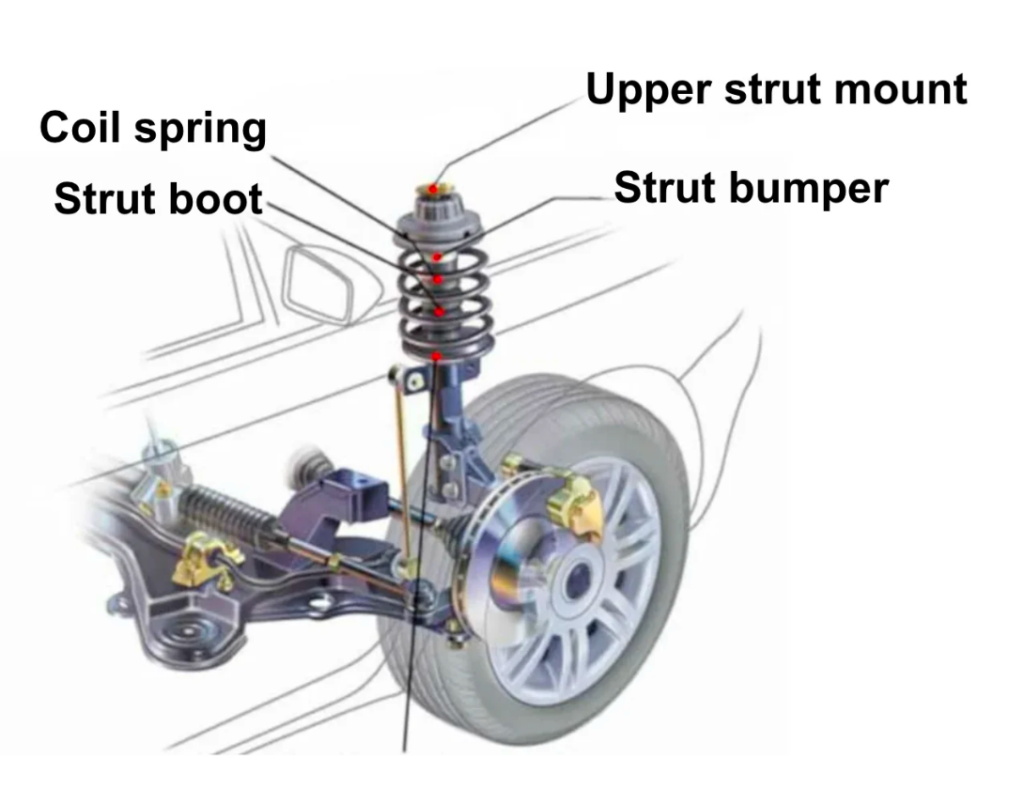
Basically, with a strut bearing, low but constant friction is provided to allow the suspension system smoothly move when you turn a car.
If the strut mounting/bearing goes bad, it will cause a play in the wheel and loss of control of the steering wheel. So, due to this reason, the steering wheel can also turn by itself.
The below Youtube video is quite helpful to understand strut bearing:
The control arms of your vehicle are important. Control arms connect parts of the suspension system. They join the frame, suspension, and steering knuckle.
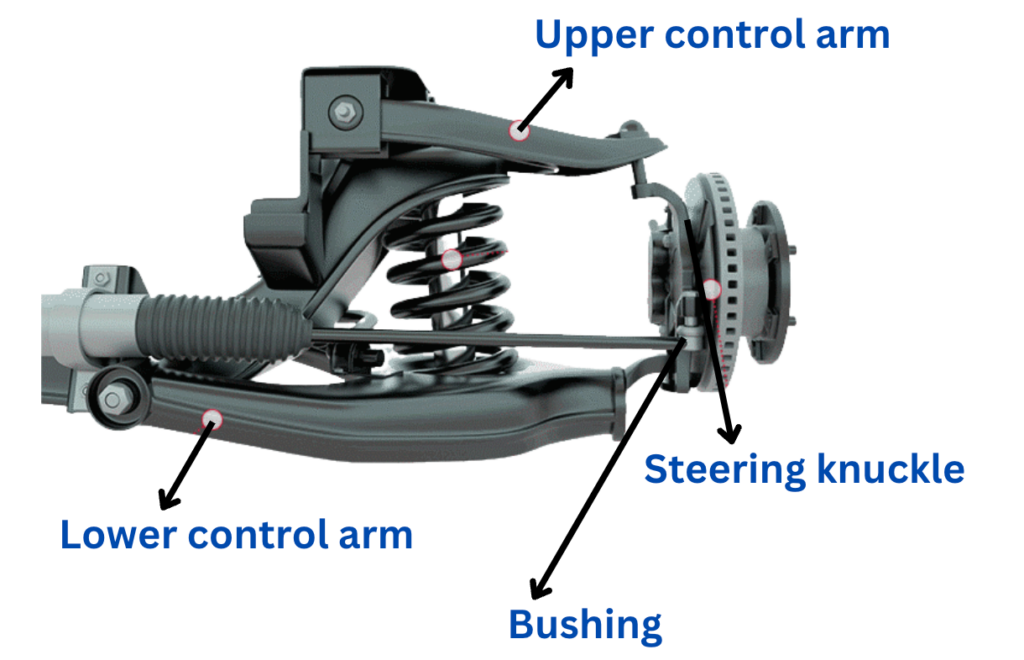
Some vehicles just have a lower control arm. Other vehicles have upper and lower control arms. The control arms connect to the frame and steering knuckle using rubber bushings or ball joints.
If the bushing and ball joint are damaged, they will shift the alignment of the vehicle’s steering and will cause the steering wheel to pull right or left by itself when driving.
8. Trapped Air In The Power Steering System
Air is usually trapped in the power steering system that is hydraulically operated. The working of the hydraulic power steering system is the same as the hydraulic braking system in which a piston moves back and forth when fluid pressure is applied.
The power steering system has a pump that pulls steering fluid from the reservoir through the return line and pushes it through the high-pressure line. The pump is driven by the engine through a belt drive system.
How to diagnose?
First, you should check if the steering fluid line is bent or kinked in. Also, carefully look at the steering system diagram of your respective engine and verify that lines are hooked up correctly.
The air can enter the steering system through hoses and a steering fluid reservoir. If the reservoir is clogged up or it is empty at some point, it will suck a ton of air.
How to fix?
To bleed the air out of the steering system, you need to lift the wheels of the car off the ground and turn the steering wheel lock to lock around 20 times before you start the car, and check the fluid reservoir for any air bubbles.
Also, after you start the car, turn the steering wheel lock to lock several times. This will pressurize the system and bleed out the air.
9. Low Tire Pressure
Low tire pressure can also cause the steering wheel to turn either left or right by itself. Usually 35 psi pressure is recommended in the front tires of the car. If one of the front tires has a lower pressure, it will lean the car and change the alignment.
As a result, it will pull your car to one side and turn the steering wheel without your control. Moreover, uneven tire pressure also causes uneven wear on the tire either on the center (overinflated) or on the outer edges (underinflated).
This condition will intensify the condition of your car pulling to one side and turning of the steering wheel to either left or right.
Final Thoughts
In summary, the steering wheel turning by itself is worrying. It can make driving unsafe. A few things can cause this:
- Tires wearing unevenly. This pulls the car to one side. Check tire pressure often. Replace badly worn tires.
- Low tire pressure. This makes steering loose. Always fill tires to the right psi.
- Stuck brakes. Sticky brake fluid or damaged hoses pull the wheels when braking. Lubricate brake parts and replace worn hoses.
- Broken steering parts. Worn tie rods, struts and bushings make steering wander and loose. Replace damaged pieces so steering works right.
- Trapped air. Air bubbles in the power steering fluid stop it from working right. Bleed the lines to take air out.
Some First Hand Experiences Shared By People In Different Communities
Our team conducted research across various online communities, forums, and subreddits to gather user comments and opinions on “steering wheel turning by itself”.
User 1 says:
Noticed my Outback’s steering felt like it had a mind of its own, especially in the rain. Turned out the tires were badly worn. Got a new set of all-season tires, and it’s been handling perfectly ever since.
User 2 says:
My Malibu started pulling to the right out of the blue. After a bit of Googling, I suspected a stuck brake caliper. Took it to a mechanic, and I was right. Replaced the caliper, and it drives straight as an arrow now.
User 3 says:
Experienced some self-steering in my Civic. Initially thought it was just me, but nope. A friend suggested checking the tire pressure, and sure enough, one tire was way low. Equalized the pressures, and it fixed the issue!
User 4 says:
Noticed my Sorento’s steering wheel was turning on its own during drives. It turned out to be a problem with the power steering pump. Replaced the pump, and it’s been perfect since.
User 5 says:
Recently, my Audi’s steering wheel started turning slightly on its own. After some digging, I discovered it was due to a failing steering angle sensor. Replaced the sensor, and the issue was resolved.
How did you fix your steering wheel turning by itself issue? Please vote.
[yop_poll id=”16″]
